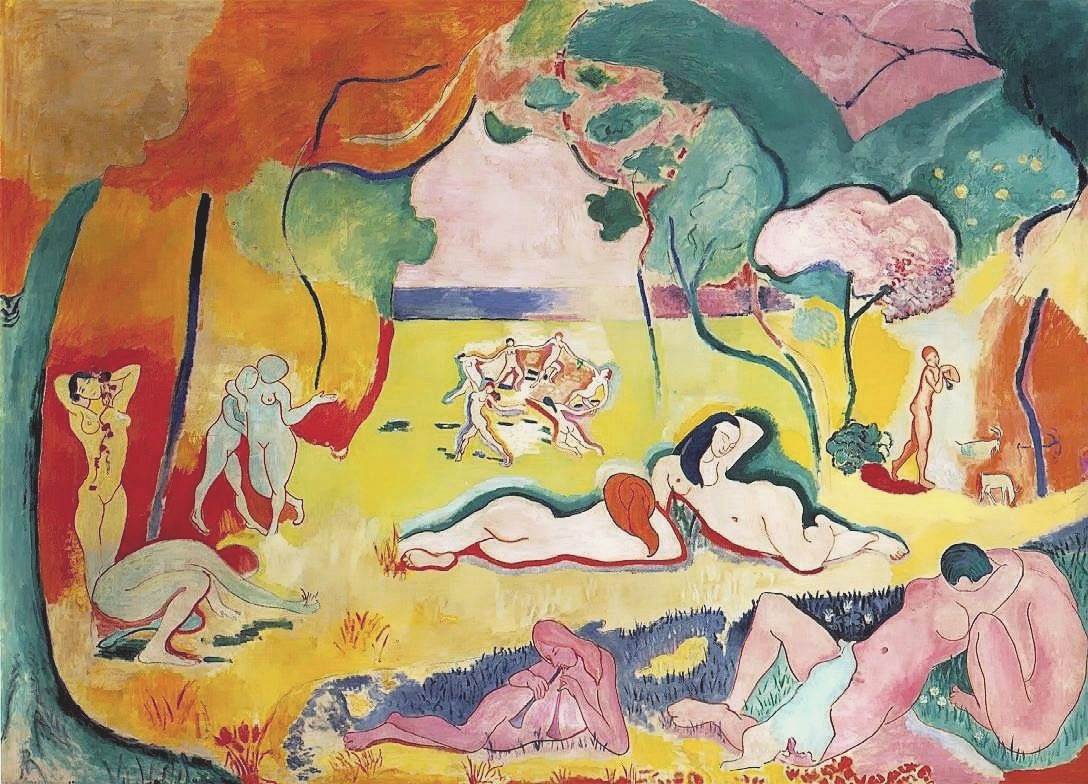Written by Charity Vincent
Henri Matisse was one of the most influential artists in the formation of modern arts. Matisse was a French painter, draughtsman, printmaker and sculptor in the early Modern era of art. The artist’s unique style and innovative ideals earned him an eternal place in art history. Matisse’s style can arguably be broken into three key elements: arbitrary color, fluid contours, and “wild” subject matter. “Wild” can be unpacked to mean gestural, free, erotic, light, happy, and overall inappropriate content for his era.
Henri Matisse was one of the most influential artists in the formation of modern arts. Matisse was a French painter, draughtsman, printmaker and sculptor in the early Modern era of art. The artist’s unique style and innovative ideals earned him an eternal place in art history. Matisse’s style can arguably be broken into three key elements: arbitrary color, fluid contours, and “wild” subject matter. “Wild” can be unpacked to mean gestural, free, erotic, light, happy, and overall inappropriate content for his era.
_by_Matisse.jpg) |
| The Dance (First Version) by Matisse |
Matisse was born on December 31, 1869 in Le Cateau-Cambrésis, France. Matisse was born into the wealthy household of a merchant, where he was brought up sternly yet lovingly. Matisse’s father supplied him with prime education and law school in Paris. However, by the time Matisse finished with his training in 1888, he was dissatisfied with his field. The artist claimed he developed his eye for color from his mother, and rightfully so, because it was his mother who introduced him to painting in 1889. His mother had brought him color paints in hopes it would cheer up Matisse as he recovered from illness. Matisse started with still lives and became immediately consumed with an intense love for painting.
Not long after starting his artistic career, Henry Matisse became a forerunner in the Fauvism movement. The Fauvists believed in freedom and nature. Fauvist work contained loose lines, brash brush strokes, strong colors, and blunt distortion of space. Fauvists were more concerned with the pleasures of life and innate desires, than structural and representational concepts. In their attempts to portray life as nature, the Fauvists drew a lot of influences from African sculpture, which is abstract, stylized, and geometric in style. This look was seen as primitive and savage during that time. The Fauvists called themselves les Fauves, or “the wild beasts.” Matisse, along with André Derain, led the Fauvist movement forward by creating numerous paintings containing all of these Fauve elements.
Not long after starting his artistic career, Henry Matisse became a forerunner in the Fauvism movement. The Fauvists believed in freedom and nature. Fauvist work contained loose lines, brash brush strokes, strong colors, and blunt distortion of space. Fauvists were more concerned with the pleasures of life and innate desires, than structural and representational concepts. In their attempts to portray life as nature, the Fauvists drew a lot of influences from African sculpture, which is abstract, stylized, and geometric in style. This look was seen as primitive and savage during that time. The Fauvists called themselves les Fauves, or “the wild beasts.” Matisse, along with André Derain, led the Fauvist movement forward by creating numerous paintings containing all of these Fauve elements.
 |
| Le Bonheur de Vivre (The Joy of Life) by Matisse |
Arguably, Matisse’s most known and celebrated painting is The Joy of Life, painted in 1905. This painting is a depiction of numerous nudes dancing, lounging, and exchanging intimacies. All the figures interact harmoniously with the others, as well as the trees, even though the space is a bit crowded with people and shrubbery. The bodies of the subjects are elongated, fluid, and graceful and become unanimous with nature itself. The colors are arbitrarily decided upon, yet all fade into each other with luminescent beauty. The perspective of the painting causes the audience to feel as if they are spying on an erotic natural process from nature itself, the leaves and branches framing the scene. Matisse is quite known for his simplified, yet fluid nudes. The Joy of Life is a quintessential example of both Matisse’s style and chosen subject matter.
There are many more examples of modern and contemporary art at Thumbprint Gallery in La Jolla. The gallery features local artists as well as artists from around the country. The gallery is open to the public Wednesdays, Thursdays, Saturdays and Sundays from 12pm-4pm and is located at 920 Kline St. #104 in La Jolla, San Diego.
Sources:
There are many more examples of modern and contemporary art at Thumbprint Gallery in La Jolla. The gallery features local artists as well as artists from around the country. The gallery is open to the public Wednesdays, Thursdays, Saturdays and Sundays from 12pm-4pm and is located at 920 Kline St. #104 in La Jolla, San Diego.
Sources:

No comments:
Post a Comment